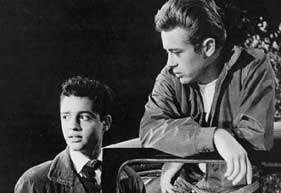
| Hollywood
and the Beat Generation:
The Beats held a very unique relationship with the mainstream film industry in the 1950s. As film critic and professor David Sterritt acknowledged, beat writers of the 1950s “deeply distrusted the sort of mass-produced culture that Hollywood represented…” but goeson to say “Hollywood took a complementary position of opposing beat values(sexual license, anticonsumerism, utopianism, etc) through strategies ofmockery, co-optation, and containment” (15). The big studios of the ‘50s were hesitantto condone or promote the offbeat culture associated with the Beats, thoughthey were eager to capitalize off the new rebellious youth culture. Likewise,the Beats had no intention of aligning themselves with the film industry,but they weren’t above hoping to someday purify Hollywood of its corruptnature. Some beat writers hoped to use popular films as a medium to communicatewith a broader and more diverse audience, that which contained their target-- the squares, the bourgeoisie, and the middle class. As the Beat movement began to gain popularityin the mid 1950s, Hollywood seemed to recognize that they could capitalizeoff this new youth culture, and started making beat related films. Mostof the films were created simply as entertainment and portrayed the Beatsin highly unflattering terms. Only a few popular films were more sympatheticto the Beats and were aligned with beat sensibility. However, it was apparentthat no true relationship could be held that would make both Hollywoodand the Beats happy. The major film studios first ventured intobeat culture in 1954 with Stanley Kramer and Laslo Benedek’s The WildOne. The Wild One incorporates beat fashion and a few elementsof beat culture into the movie by portraying the main character (playedby Marlon Brando) as the leader of a traveling motorcycle gang. Connections to beat culture can be made in many scenes throughout the movie, particularly when the gang takes over a restaurant; a little “boppish scat-singing” takes place, with jazz blaring from a jukebox in the background. John McClellon Holmes recognized that “the‘50s were a time of much youth-centered anguish in grown-up circles. Parents,civic leaders, law officers, and even literary critics were ‘outraged’by a long list of phenomena” (Sterritt 79). The Wild One representsthe uncertainty felt towards the new rebellious popular music and youthculture of the ‘50s, and acts as a warning to the adult audience that suchbehaviors and trends could occur in any town. Regardless of the intentionsof the writers, this movie had an important role in influencing many teensacross America.
Scene from Rebel Without A Cause (Warner Bros,1955) One of the most famous teen films fromthe 1950s was Nicholas Ray’s Rebel Without a Cause (1955). Thisearly excursion into beat territory “tapped into pervasive undercurrents of dissatisfaction in fifties society” and is “stunningly in tune withthe Beat sensibility” ( Carney2000a, 2). Rebel Without a Cause dispelled the notion of theperfect nuclear family, and exposed such families as dysfunctional — “seriouslydamaged by neglect, parental discord, and repressed sexuality, with adultsunable to understand the simplest needs of the young” (Dickstein 33). Asa result, the main characters in the movie, led by James Dean, formed amore nurturing alternative family among themselves. Ultimately, Rebel Without a Causegave a striking yet controversial commentary on American culture. It provideda voice for many disenfranchised teenagers who had never had a chance tospeak up, and eloquently articulated many of the problems within society.James Dean seemed to speak to young people in the mid-1950s ? his performancemade him an idol among youth, and helped to shape Beat manners and mannerisms. With the popularization of the Beat Generationin the late 1950s, Hollywood saw a boom of exploitative films made specificallyabout or pertaining to beat culture. Many of the filmmakers had only asidelong interest in the Beat Generation or anything connected with it? the directors seemed concerned only with reassuring and entertaining their audience. The exploitative Hollywood films “generally try to defusepotential interest in beat lifestyles by mocking, parodying, or misrepresenting them” (Sterritt 141) and certainly would not appear to emulate or endorse the Beat phenomena. In Charles Haas’ film The Beat Generation(later released as This Rebel Age 1959), the Beats are portrayedunder highly unflattering terms. In this “cop-and-crook melodrama,” theonly reference made to beat culture is with the villain, a beatnik namedStan whose hatred of women leads him to commit a number of rapes. The plotrevolves around an officer’s quest to track the beatnik rapist down. Thismovie makes no significant references to any positive aspects of Beat culture,but simply passes it off as “a bunch of ‘kids’ too immature to accomplishanything substantial in life or even to notice (or care about) the presenceof a demented rapist in their midst” (Sterritt 151). Hollywood’s hostile excursion into Beatlife was also prevalent in another 1959 film called A Bucket of Blood,directed by Roger Corma. This film deals with Beats in highly unconventionaland misleading ways, and again turns the stereotypical beatnik into a murderousvillain. This time the pseudo-beatnik is an awkward, self-conscious employeeof a coffeehouse who aspires to be respected by the other beatniks. Hegets that respect after he secretly murders a number of people and turns them into clay sculptures. A Bucket of Blood reveals its condescensiontowards artists and the Beat scene in general and continues with an un-Beatfriendly tone throughout the movie. Copyright 2000. By Mike Harpring. |
